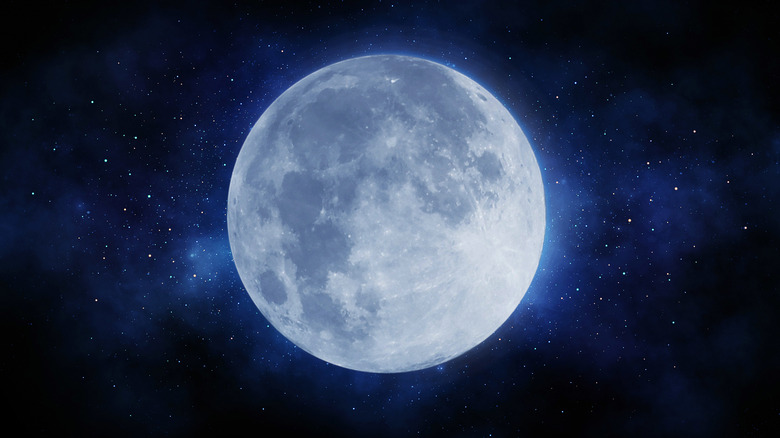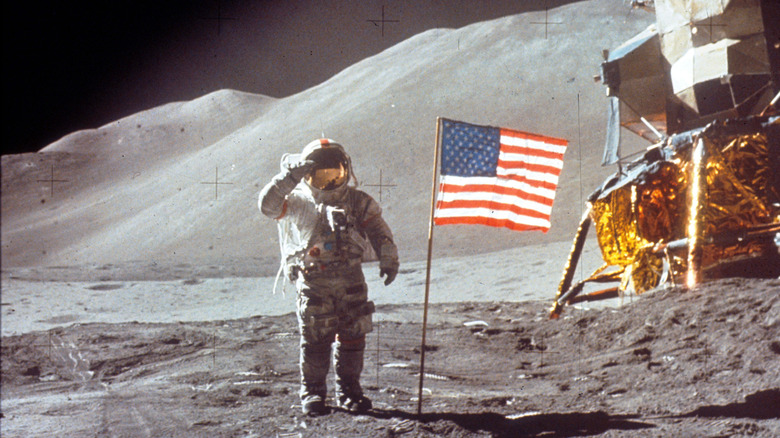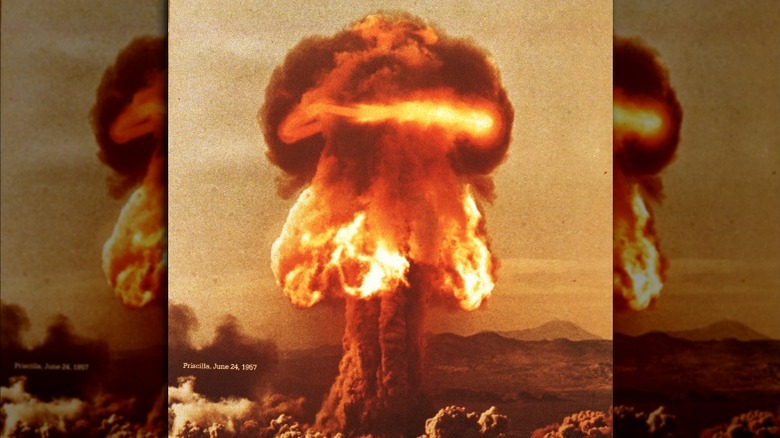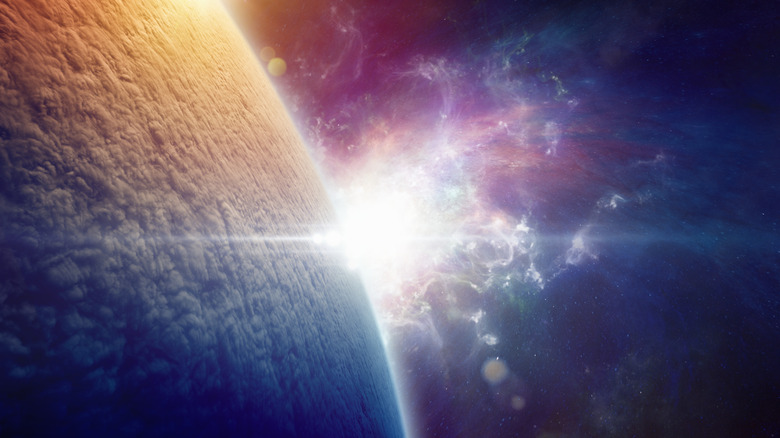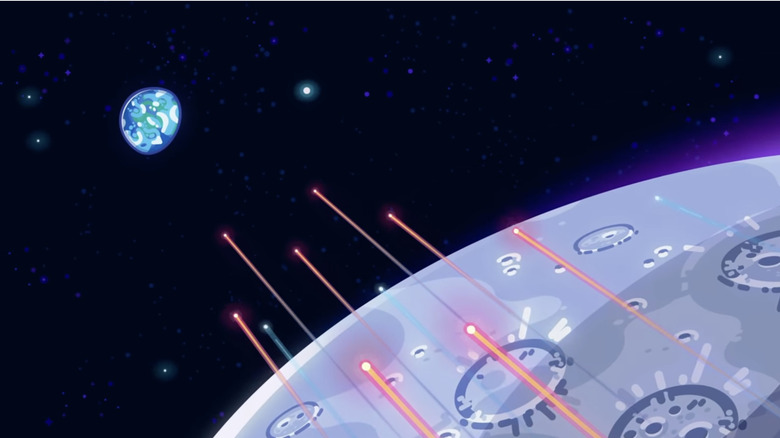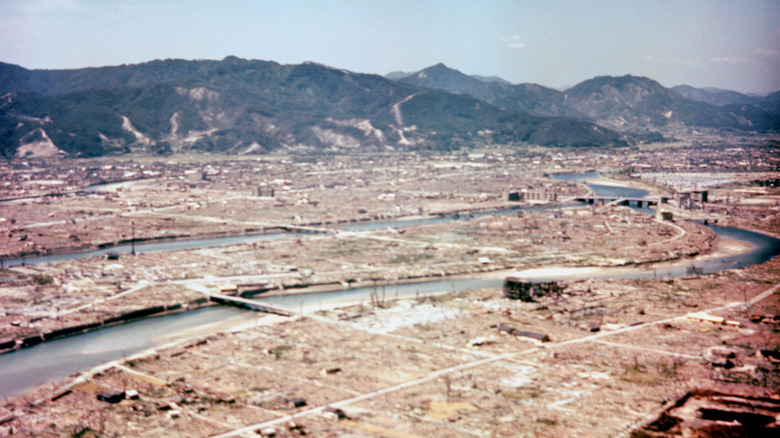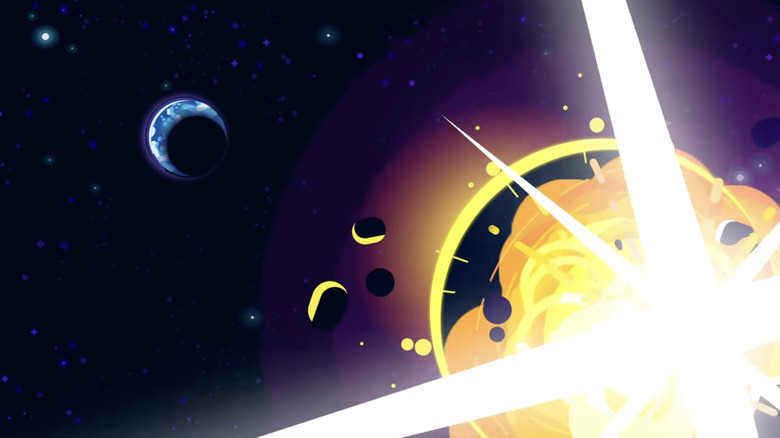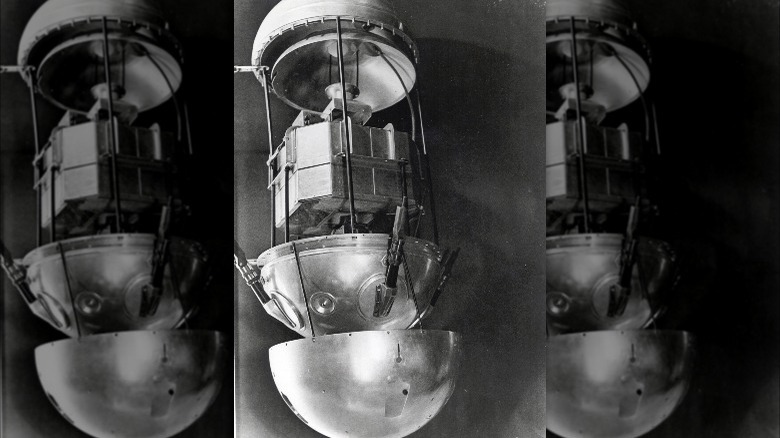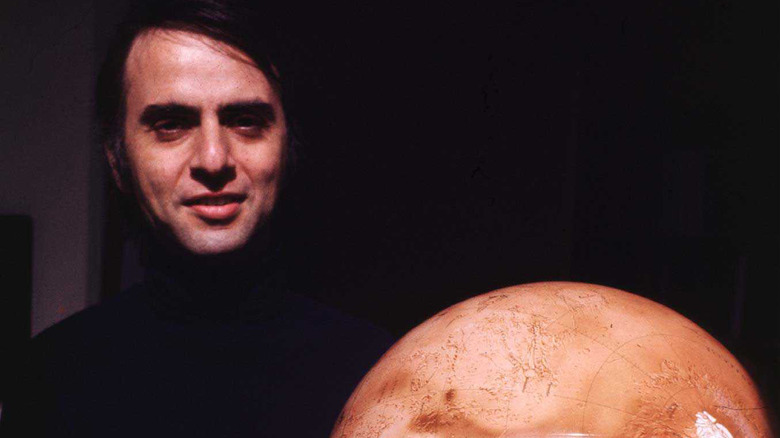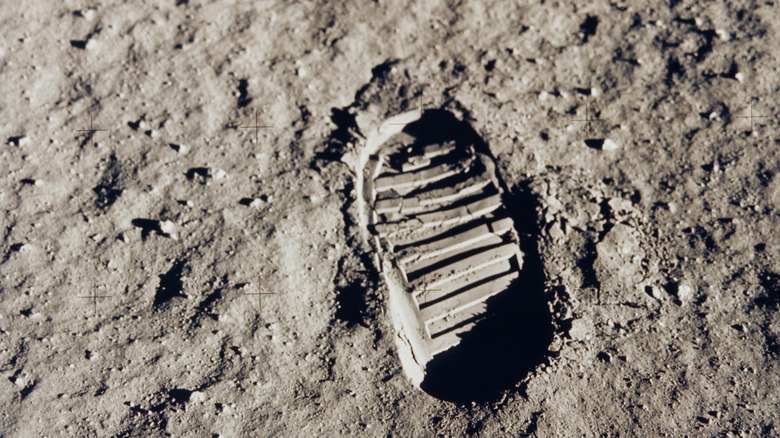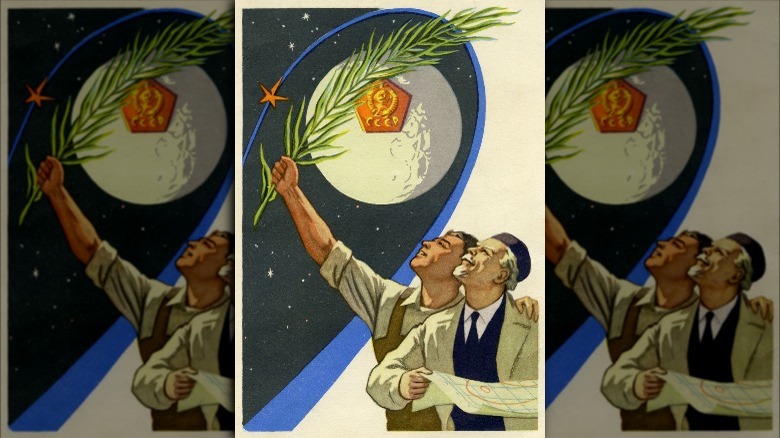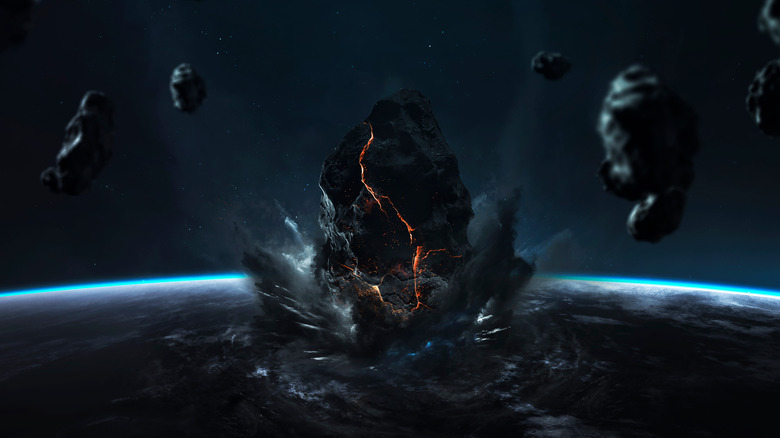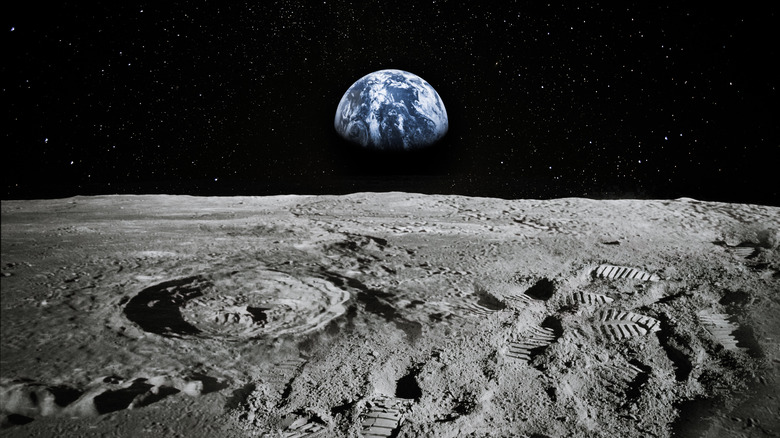Here's What Would Happen If We Nuked The Moon
On July 16, 1945, the first nuclear test took place, ushering in the Atomic Age, a period that saw more than 2,000 detonations by at least eight nations (via Atomic Archive). Top test sites used worldwide include Nevada, parts of Algeria, the Pacific atolls, parts of Kazakhstan, and the South Atlantic. But few of us have likely entertained the question, "What would happen if we nuked the moon?" After all, this gratuitously violent act would serve no real purpose save messing up the Earth and larger universe, right? Unfortunately, not everyone thought that way in the 1950s.
It might surprise you to discover that American researchers looked for ways to "militarize the moon" from the late 1940s through the early 1990s, according to the Nerdist. Not only did they entertain the idea of bombing the celestial body, but they also planned to build military bases there. Well-documented studies took place, all with the stated intent of determining what Earth's satellite "could offer a nuclear-armed nation."
A surprising cadre of United States officials researched the potential of nuking the moon, and so did their Soviet counterparts. Why? To send a "shot over the bow." The USSR had been on a winning streak in space since the successful launch of the satellite Sputnik in 1957, and they weren't about to play second fiddle to the U.S. As for America? The nation desperately wanted to catch up. Here's what would happen if we nuked the moon and the even stranger history behind the question.
A 100 megaton thermonuclear warhead
On the hit YouTube channel, Kurzgesagt addresses the topic of atomic bombing the moon. The video marks a great place to begin a theoretical journey into what a 100-megaton thermonuclear warhead, "twice as powerful as the most powerful nuclear bomb ever detonated," would do to Earth's iconic satellite.
Not surprisingly, the idea for the topic came from the United States Air Force's commissioned study on the subject in the 1950s. But instead of the relatively small warhead the U.S. actually planned, the idea was posed using the "splashier" 100-megaton bomb. How does a bomb this size compare to what's been detonated on the Earth?
According to Live Science, the Soviets received the honors for detonating the largest nuclear blast in history in October 1961, the 50-megaton Tsar Bomba. They did so over an uninhabited island near the Arctic Circle 2.5 miles in the air. The result? "Onlookers saw the flash more than 600 miles (965 km) away and felt its incredible heat within 160 miles (250 km) of Ground Zero. The bomb's gargantuan mushroom cloud climbed to just below the edge of space." Of course, the aftermath of a blast on the moon would prove different because of its unique atmosphere, but one thing's for sure: If the moon got nuked, there'd be a mess on our hands.
Talk about a cleanup job
Despite the distance between the Earth and its lunar companion, the explosion would prove massive, per Nerdist. Why? Because the moon doesn't have an atmosphere to offer a shield against (and a container for) a detonation. As explained by NASA, "When a nuclear weapon is detonated close to the Earth's surface the density of the air is sufficient to attenuate radiation (neutrons and gamma rays) to such a degree that the effects of these radiations are generally less important than the effects of blast and thermal radiation."
Expect a vast, unimpeded blowout larger than anything imaginable on the blue planet, as reported by Kurzgesagt. NASA documents support this hypothesis, describing a nuclear weapon's explosion in a vacuum (e.g., space). Without an atmosphere to keep things in check, you wouldn't see a blast or thermal radiation because there'd be no air the blast wave could heat. The weapon would emit higher frequency radiation, the fallout from which could only be mitigated by physical distance. According to NASA, "The range of significant dosages will be many times greater than is the case at sea level."
On July 9, 1962, NASA launched "Starfish Prime," one of five nuclear tests designed to study atomic weapons in lower outer space (via the Comprehensive Nuclear-Test-Ban Treaty Organization). The radiation from "Starfish Prime" and other high-altitude nuclear tests created an artificial belt of radioactive destruction, devastating one-third of all satellites in lower orbits.
Spectators would be in trouble
Unlike "Starfish Prime," the moon doesn't exist in a total vacuum. It has an atmosphere. But according to Lunar Science and Exploration, this atmosphere proves "very tenuous." What does that mean? The gases within this lunar atmosphere escape easily into space due to the "pie in the sky's" very low gravity. (That's also what gave Neil Armstrong and Buzz Aldrin their characteristic "bounce" during their iconic moonwalk.)
What else might happen due to the lack of atmosphere? According to Nerdist, any astronauts observing the explosion within several miles would die almost immediately. What's more, individuals watching the blast from orbit might also be in harm's way. In essence, no safe viewing distance of the lunar nuclear event would exist because "anyone close enough to get a good look would be exposed to fatal amounts of radiation."
According to Kurzgesagt, the explosion would also cause a moonquake. This planetoid-wide event would occur because the moon is much smaller than the Earth. Yet, it would be "comparable to an earthquake of seven on the Richter scale," likely to destroy any infrastructure left by astronauts on the lunar surface. But the devastation wouldn't stop there.
Orbital shifts wouldn't be a thing
What else could might be expected amid the chaos? As reported by Kurzgesagt, the explosion could "excavate as much as 100,000,000 m³ of dust and rock, forming a crater a kilometer across while bedrock is pulverized to rubble. Debris is shot into the sky in every direction. Again, without an atmosphere, there's no drag to slow it down."
These micro meteorites would explode into space, hitting unlucky satellites and spaceships along the way before raining down on the Earth or venturing off towards the furthest reaches of the galaxy. Most would prove no bigger than small rocks by the time they touched down on planet Earth, and the explosion itself would look like little more than a momentary flicker.
But what about other potential consequences? Wouldn't a nuke knock the moon out of its orbit, leading to catastrophe for the Earth and its inhabitants? Not so much. According to Nerdist, the bomb would barely impact the moon's orbit. Think of it as the equivalent of a feather shoving a semi-truck. Not gonna happen!
Bigger bombs and orbital shifts
So, what would it take to disturb the moon's orbit? According to INSH, you'd need a much bigger bomb for that. Let's put this in perspective. Today's most powerful nuclear bombs boast a yield of 50 megatons of TNT, which is equal to the destructive power of 3,800 Hiroshima bombs. As for shifting the moon's orbit, you'd need the equivalent of 10 trillion megatons of TNT to do the job. Ten trillion megatons ... Yes, you read that right!
This massive destructive force would shove the moon away from the Earth, causing havoc in its wake. After all, without the moon orbiting around the blue planet, the Earth would suddenly get exposed to meteors. What's more, the lack of lunar influences would impact the tides in drastic ways. In turn, this would lead to the deaths of all marine life. And if that's not enough, you'd have to kiss the seasons as you know them goodbye. In other words, it would be no bueno.
Many people assume that the question, "What would happen if we nuked the moon?" represents a mental exercise by a YouTuber interested in theoretical science (and gaining more viewers). But there's another question worth asking, according to IFL Science. Why did the United States (and the USSR) study the effects of nuking the moon in the first place?
Sometimes truth is stranger than fiction
The United States Air Force seriously considered detonating a nuclear bomb on the moon at the height of the Cold War in the late 1950s, per IFL Science. Mind-blowing, right?
How is this really true? A declassified 190-page report created by the Air Force Nuclear Weapons Center and dated June 1959. Known as Project A119, the report studied the real-life impacts of a nuclear detonation on the moon. It also covered how the military could make observations on the lunar surface, including seismic activity, following the blast. And it hypothesized about the repercussions of such a detonation, like how long nuclear fallout would persist on the extraterrestrial body.
It's important to remember that the nuclear warhead considered for detonation on the moon proved much smaller than the hypothesized 100-megaton bomb. The Air Force discussed dropping a W25 warhead with a 1.7-kiloton yield, according to IFL Science. While still no joke, people wouldn't have had to contend with the stuff that Kurzgesagt discusses, including the excavation of the moon's surface, pelting the Earth and surrounding environs with micro meteorites. And no one would have to sweat INSH's projection of the moon getting displaced from its proper orbit around the Earth. Or the tidal, seasonal, and meteoric devastation resulting from it. Nevertheless, the thought of nuking the moon is still anxiety-producing.
Project A119 would've turned the Space Race violent
Project A119 or "A Study of Lunar Research Flights" represented a top-secret effort created in 1958 by the United States Air Force, per Space Legal Issues. According to Air Force documents, Project A119's stated objective was to detonate a nuclear bomb on the moon. Why? To help answer questions about the mysteries of astrogeology and planetary astronomy.
But researchers had a more sinister motivation despite the "official" narrative that nuking the moon would be done solely for scientific purposes. They wanted to send the Soviet Union a message following the successful launch of the Soviet satellite Sputnik on October 4, 1957. Rumors also abounded that the USSR planned on detonating a hydrogen bomb on the moon, and the U.S. wanted to beat them to the chase. Some say the scheduled detonation would occur on the anniversary of the October Revolution.
Project A119 included top astronomers and scientists of the day, yet the plan ultimately had very little to do with science. Headed up by physicist Leonard Reiffel, the future deputy director of the Apollo program at NASA, he saw the exercise as a way of "flexing muscles" (via IFL Science).
Carl Sagan worked on Project A119
Speaking about the project to The Guardian in 2000, Leonard Reiffel would note, "It was clear the main aim of the proposed detonation was a PR exercise and a show of one-upmanship. The Air Force wanted a mushroom cloud so large it would be visible on Earth." While detonating the explosion on the dark side of the moon would've proven optimal, Reiffel noted the moon's terminator became the focus. The terminator is the delineation point between the moon's light and dark sides. In other words, the sun would highlight the mushroom cloud.
Why the need for such force? Reiffel attributes it to how far the U.S. had fallen behind in the so-called "Space Race." He also notes that the warhead they planned on using contained the same amount of power as the bomb dropped on Hiroshima at the end of World War II.
Who else worked on the project besides Reiffel? None other than famed scientist Carl Sagan. How did Sagan contribute to the research? Reiffel asked Sagan to enhance the explosion by getting the most out of the blast possible in terms of visibility. According to IFL Science, Sagan's name remains a prominent part of the declassified Project A119 report, appearing on the contributor list. Other individuals involved in the research include Gerard Kuiper, a researcher who has contributed significantly to our understanding of contemporary planetary science.
Lagging in the Space Race
On July 20, 1969, the United States clinched top Space Race honors with the landing of Neil Armstrong and Edwin "Buzz" Aldrin on the moon (via NASA). Reflecting on this impressive history, it may come as a surprise to many to find out that the United States lagged significantly behind the Soviet Union every step of the way in the Space Race. With regard to setting foot on the lunar surface, most bets weren't on the U.S. at all. According to Forbes, "If any nation was going to do it, most thought it would be the Soviet Union."
After all, the Soviets successfully placed the first satellite, Sputnik, in orbit on October 4, 1957 (via NASA). And the milestone-hogging didn't stop there. The Soviets were also the first to send humans into outer space and the first to place a crewed spaceship in orbit around the Earth. They also boasted the first female cosmonaut, first spacewalk, and the first non-Earth landings.
The point of all of this? The United States remained woefully behind the Soviets for much of the Space Race, as reported by IFL Science. Attempting to catch up seemed nearly impossible, hence the focus on bombing the moon. But even here, the U.S. wasn't pioneering new territory. You see, the Soviets also researched detonating a nuclear bomb on the moon, according to Russia Beyond.
Joining the moon nuking party
The Pittsburgh Post-Gazette reported on the Soviet Union's plans to nuke the moon on November 1, 1957: "The latest rumor going the rounds is that the Russians plan to explode a rocket-borne H-bomb on the moon on or about Nov. 7. If that's true — look out! The rocket and its cargo of violence are more likely than not to boomerang."
A preposterous claim by a newspaper bent on selling copies? Think again. The world came shockingly close to a Soviet moon nuking. On September 14, 1959, the USSR landed an automatic probe known as the Luna-2 on the moon, as reported by Russia Beyond. Following a 33-hour flight, the probe landed on the planetoid's surface, initially launched from Baikonur, USSR. Not only was the U.S. incapable of pulling off a similar trick, but the feat proved so impressive, T. Keith Glennan, NASA's first administrator, could do little more than offer a congratulatory message to the USSR.
Later, Soviet leader Nikita Kruschev would present President Dwight Eisenhower with a replica of the pennant on the moon probe. Saccharine praise and gift exchange aside, the Soviets had seriously considered arming Luna-2 with a nuclear warhead. Regarding the failed trajectory of the many launches leading up to Luna-2, the probe could have easily boomeranged back onto the USSR, wreaking atomic devastation. Or it could've landed just about anywhere on the planet, kicking off World War III.
Why the Soviets wanted to nuke the moon
How did the Soviets come up with the idea of placing a nuke on the Luna-2? According to Russia Beyond, the suggestion came from Yakov Zeldovich, an atomic physicist and lead researcher of the Luna-2 project. Why did Zeldovich think arming the lunar probe with a nuclear warhead made sense? Because he feared the Luna-2's small size would create a seriously underwhelming "poof" upon landing on the moon. So, he wanted to spice it up with a little nuclear action.
During the Cold War, Boris Chertok worked as a close aide of one of the USSR's space program chiefs, Sergey Korolev. Later, he would reflect in his book, "Rockets and Humans," on why the Soviets wanted to bomb the moon and just how close they came. He explains, "The idea was that when the explosion took place, it would be accompanied by such a massive flash that every space observatory with its gaze trained on the moon would be able to register it" (via Russia Beyond).
Fortunately, Chertok and the other USSR space program director, Mstislav Keldysh, talked Korolev out of the risky experiment by underscoring the genuine and serious risks involved with arming the Luna-2. Ultimately, there were too many places other than the moon where the payload might have landed. And none of those outcomes was worth the "big splash" they hoped to get.
The moon-nuking plan got nixed
Fortunately, the United States' moon-nuking plan also got nixed for various reasons, according to History. Not only did leaders fear the immense public "fallout" resulting from the event, but scientists also worried that radiation from the nuclear blast would prevent the military from later establishing bases on the moon. Concerns were also raised about potential health impacts on Earth.
According to Leonard Reiffel, he also made a plea for leaving the moon alone for other reasons. "I made it clear at the time there would be a huge cost to science of destroying a pristine lunar environment" (via IFL Science). What's more, Reiffel believed any crater created on the moon because of its bombing would ruin the "man in the moon." Scientists in the late 1950s also hypothesized that microbial life might exist on the planetoid, and none of them wanted to get implicated in killing it.
Despite contemplation of nuking the moon, it thankfully never took place. And the U.S., USSR, and the world also gleaned important lessons from these outlandish propositions. Today it's illegal to nuke the moon thanks to two treaties, 1963's Partial Nuclear Test Ban Treaty and 1967's Outer Space Treaty. So, the "man in the moon" and the inhabitants of the Earth can all breathe a sigh of relief. Nevertheless, there remain pushes to militarize space, which according to David Lowry, a British nuclear historian, "will seem as incredible as the idea of nuking the moon in the Fifties seems today" (via The Guardian).
